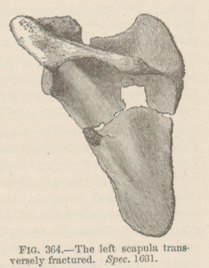Title: Gazell, John
Source text: The Medical and Surgical History of the War of the Rebellion. (1861-65.), Part 3, Volume 2 (Washington, DC: Government Printing Office, 1883), 650.
Civil War Washington ID: med.d2e24974
TEI/XML: med.d2e24974.xml
CASE 966.—Fracture of scapula, humerus, and forearm; railroad accident.—John Gazell, a laborer of the Commissary Department, U. S. A., aged 36 years, was run over by a city passenger railroad car at Washington, August 10, 1863, and died at Douglas Hospital one hour after the accident. Acting Assistant Surgeon J. E. Smith made the following report of the injury: "Everything to alleviate his sufferings was done that could be, but the man did not react from the shock in the least. At the autopsy a tumor was observed on the right side of the throat which was supposed to have resulted from the injury, but on cutting down upon it I discovered it to be a pre-existing enlargement of the thyroid gland. A section of the tumor displayed fatty degeneration of the greater part with two sacs, each containing about one-half ounce of sero-sanguinolent fluid. The left inferior portion of the tumor was ossified. Previous to his death the patient had passed bloody urine which could not be satisfactorily accounted for, the kidneys, ureter, and bladder being found apparently uninjured. The right humerus was comminuted, as were also the radius and ulna of each forearm. On the left anterior side the ribs were all broken except the twelfth, and the lung was considerably lacerated; posteriorly the same ribs were fractured except the first, second, and twelfth. The left scapula was transversely fractured below its spine and the left clavicle at its acromial extremity." The injured scapula (FIG. 364, Spec. 1631), humerus (Spec. 1786), and both bones of both forearms (FIGS. 363, 365, Spec. 1784 of the Surgical Section of the Museum), were contributed by Assistant Surgeon W. Thomson, U. S. A., and are represented in the adjoining wood-cuts. The left radius and ulna show an oblique fracture at the junction of the upper thirds, the superior fragments being wanting, while in the right radius a nearly transverse fracture exists in the lower part of the middle third and longitudinal fractures occupy the lower fragment. The lowest third of the right ulna is comminuted.


